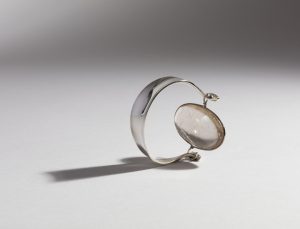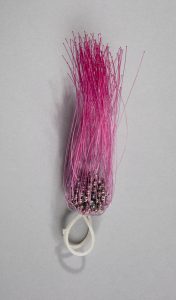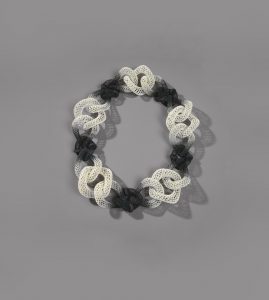Jewelry concepts over carats
Five years ago, art jewelry collector Susan Grant Lewin surveyed her collection of over 200 pieces of collectible artist jewelry, and faced the same question all collectors face—what is the legacy of my collection?
For Susan, her intention was clear—to promote the aesthetics, visibility and education of an underappreciated art form to a wider audience. She found a like-minded ally at the Cooper Hewitt Design Museum, a Smithsonian institution in New York City.
This focused collection Susan has donated is not filled with multi-carat, multi-million dollar pieces of personal adornment. Rather, it reflects decades of innovative European and American artist-designed jewelry, and includes works from over 100 jewelers from eighteen countries. This collection, titled “Jewelry of Ideas,” espouses The Cooper Hewitt’s commitment to innovative design in all categories.
Early discoveries
For many collectors, a lifelong passion begins with a piece of memorable inspiration.
In Susan’s early career as a journalist, she traveled frequently to Europe to report on furniture trends. One year, on her annual visit to famed Danish silversmith Georg Jensen’s shop in Copenhagen, she discovered the jewelry designs of Vivianna Torun Bülow-Hübe, and acquired her first piece of art jewelry: a sterling silver bracelet with a smoky quartz pendant in the middle. Torun Bülow-Hübe’s organic rounded shape was indicative of Scandinavian elegant modernist design that influenced mid-century jewelry designers in Europe and America.1

No. 203A Bangle Bracelet, 1968; Manufactured by Georg Jensen Sølvsmedie (Denmark); silver, rutilated smoky quartz; H x W x D: 6.2 × 6 × 5.5 cm (2 7/16 × 2 3/8 × 2 3/16 in.); The Susan Grant Lewin Collection, Cooper Hewitt, Smithsonian Design Museum; 2016-34-112.
From this first acquisition, Susan was hooked. A transformative experience came when she first attended SCHMUCK, an annual International Crafts and Trades Fair held in Munich, Germany. This special jewelry show attracts emerging talents and experienced artists who use both traditional and technologically innovative techniques in jewelry design.
“I’ve been going to Munich for SCHMUCK for over a decade, and it has made me more serious in my approach to collecting,” Susan recalls. “I made a list of those jewelers who were missing in my collection, and made a concerted effort to fill the void. I wanted my collection to represent the top of the field internationally.”
Supporting the creative process
In addition to visiting fairs, galleries and museums, Susan was in a unique position to merge her collecting passion with her professional work. As Creative Director at Formica Corporation—the company known for its heat-resistant plastic laminate—she was able to foster creative use of the company’s commercial material.
“We initiated a grants program to give Formica material to artists, designers and architects to encourage innovative uses for this new material,” she recalls.
The creations that ensued were whimsical and wonderful. Robert Ebendorf, for example, used the ColorCore® to create a necklace of wooden clothespins and Formica color chips. He elevates the aesthetic potential of these un-glamourous materials, while nodding to their quotidian references to chores like housecleaning and laundry.2
Artist jewelers can be innovative in form, material or design, and sometimes all these factors at once. Not only can the material be unconventional, but the shapes can be as well.
Take Nora Fok’s Rambutan Ring, a striking piece in Susan’s collection, which is topped off with about 4 inches of magenta colored nylon filament. It’s as though the ring was sporting a colorful Mohawk over the black pearls clustered at the center of the design. A stunning piece to wear to a cocktail party, no doubt, but you should stay clear of finger foods.

Rambutan Ring, 2003; Designed by Nora Fok (English, b. Hong Kong, China, 1953); plastic, knitted, knotted and dyed nylon filament with black pearls; H x W x D: 14.5 cm x 5 cm x 3.5 cm (5 in. × 1 1/4 in. × 1 1/4 in.); The Susan Grant Lewin Collection, Cooper Hewitt, Smithsonian Design Museum; 2016-34-33.
Artists can favor form over function, which can make wearing jewelry out of feathers, coal, porcelain or sharp materials either challenging or daunting for its owners. Yet this challenge can engage the collector as well.
Has Susan actually worn every piece she has acquired? She laughs, “Wearing isn’t that important to me, as long as wearing it is implied. That is key.”
Jewelry of ideas
Much like contemporary art, artist-designed jewelry doesn’t easily reveal the creator’s conceptual ideas at first glance. The Cooper Hewitt’s “Jewelry of Ideas” exhibit captures the intent of a jewelry collection that is more than carats.
What makes this personal collection so thought-provoking? Like all good design, “(These) inventive new forms prompt us to question jewelry’s history and social function, conventional standards of beauty, and relationship of scale to the human body.”3
A 3D-printed glass-filled dyed nylon and silver necklace designed by Doug Bucci looks wearable to either a cocktail party or the office. Aside from the high-tech construction method, the black and silver connected links reflect a very traditional chain link design seen through centuries of jewelry creation.

Black Sectional Necklace from the Islet Series (Philadelphia, Pennsylvania, USA), 2011; Designed by Doug Bucci (American, b.1971); 3D-printed glass-filled nylon, sterling silver; Cooper-Hewitt, Smithsonian Design Museum; Promised gift of the Susan Grant Lewin Collection. Photo: Matt Flynn.
Yet, the shape of the design is startlingly complex and contemporary. Bucci comments, “This necklace was generated from a diabetic’s collection of blood glucose readings. The collected data was transmitted from a continuous glucose-monitoring system and wirelessly streamed in 3D modeling software.”4
Bucci’s use of 3D printing is indicative of some of the technical, digital and computer-driven innovation in contemporary art jewelry.
Art jewelry as a collectible
Considering how long humans have expressed creativity through unique items of adornment, it is surprising that American museums have not tended to acquire jewelry as much as their European counterparts.
Munich’s Pinakothek der Moderne in particular played an inspirational role for Susan.
“When I first went to the Pinakothek to view their stunning collection of art jewelry, I realized how serious this craft is, and that one could collect this kind of art jewelry on a professional, aesthetic and curatorial level. Before I had been collecting randomly, and now I began to view my approach and collecting decisions more thoughtfully.”
Although art jewelry has more collecting enthusiasts in Europe, three design schools in the United States offer Masters programs in studio jewelry: Cranbrook Design Academy in the suburbs of Detroit, MI; Rhode Island School of Design in Providence, RI; and the State University of New York at New Paltz.
Susan is excited about the possibilities, “There is so much momentum at the moment in art jewelry design. It’s a good time to buy artistic pieces that are affordable in comparison to contemporary art. Not to mention, they are wearable, and easier to store too!”
Exhibitions like “Jewelry of Ideas” offer visual and historical education on the intersection of design and adornment. With their ingenious play of color, material, and shape, these pieces, and the concepts behind them, will stimulate scholars and enthusiasts alike.
The “Jewelry of Ideas” exhibit opens at the Savannah College of Art and Design on September 20, 2018.
Katja Zigerlig is Vice President, Art, Wine + Collectibles Advisory at Berkley One (a Berkley Company).
Below are a few educational resources:
- Jewelry of Ideas: Gifts from the Susan Grant Lewin Collection
- Schmuck 2018 Munich Fair
- Art Jewelry Forum
- New York Times article: “I don’t wear jewelry. I wear art”



